
One of India’s greatest scientists CV Raman was born on November 7, 1888, in Tamil Nadu’s Trichinopoly, and died on November 21, 1970, in Bangalore.
Sir Chandrasekhara Venkata Raman was a physicist who made the ground-breaking discovery called the Raman Effect, the phenomenon of change of wavelength of light when a beam is scattered in a medium.
At the age of 42, Raman was awarded the Nobel Prize in Physics in 1930 "for his work on the scattering of light and for the discovery of the effect named after him".
On his birth anniversary, here is a look at some of the achievements of the great scientist.
Raman initially worked as a student in the field of optics and acoustics.
He completed his Master’s degree in Physics from the Presidency College, University of Madras, in 1907, and worked as an accountant in the finance department of the Indian government. In 1917, he joined the University of Calcutta as a professor of Physics.
Raman was fond of Indian classical music and was keenly interested in the acoustics of stringed instruments. He even constructed a mechanical violin.
One of Raman’s discoveries is related to the frequency response of the violin and its quality. The frequency response curve is known as the ‘Raman curve’.
Raman continued his research at the Indian Association for the Cultivation of Science (IACS) in Calcutta while he worked as a professor at the university. He later became an honorary scholar at the association.
ALSO READ:
It was at the IACS that Raman conducted the ground-breaking experiment that eventually earned him the Nobel Prize in Physics. He discovered that when light passes through a transparent substance through one frequency, a small portion of the light gets deflected at right angles to the original direction. Some of this light also appears to be of different frequencies than that of the incident light.
In 1924, Raman became a Fellow of the Royal Society and was knighted in 1929.
Raman and Suri Bhagavantam discovered the quantum photon spin in 1932, which further proved the quantum nature of light.
In 1932, Raman joined the Indian Institute of Science in Bangalore as the head of the department of Physics. He became the director of Raman Research Institute in Bangalore in 1948 and remained in the position till his death on November 21, 1970.
(Edited by : Sudarsanan Mani)
Check out our in-depth Market Coverage, Business News & get real-time Stock Market Updates on CNBC-TV18. Also, Watch our channels CNBC-TV18, CNBC Awaaz and CNBC Bajar Live on-the-go!


Supreme Court refuses plea seeking 6-year poll ban on PM
May 14, 2024 7:14 PM
Punjab Lok Sabha elections 2024: A look at BJP candidates
May 14, 2024 7:06 PM
Lok Sabha polls: EC disposes of 90% complaints related to MCC violations
May 14, 2024 4:45 PM
Jharkhand Lok Sabha elections 2024: All about INDIA bloc candidates
May 14, 2024 2:52 PM

